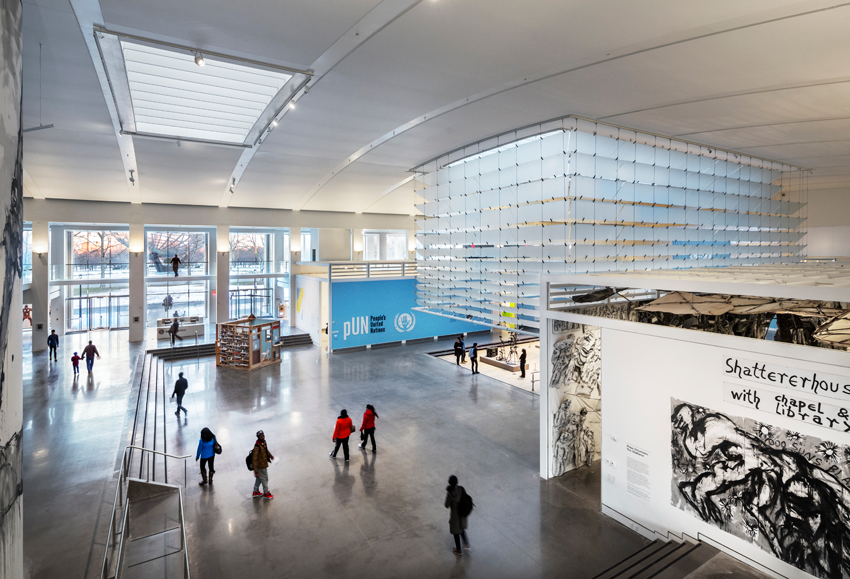[ad_1]
In Queens, the sound of ambulance sirens doesn’t stop. The borough’s Elmhurst Hospital has become central to New York’s response to the coronavirus outbreak, managing the bulk of the city’s infected residents. At the hospital’s breaking point, doctors saw as many as 13 deaths per day.
Only a few miles away from the epicenter of a global health crisis is the Queens Museum, an institution that is itself emblematic of our interconnected world. During the late 1940s, the building hosted the General Assembly of the newly formed United Nations; in 1964, it stood at the center of the World’s Fair, which showcased cultural and technological innovations from 80 countries. But nowadays, the museum doors are closed to visitors as city officials erect a field hospital nearby at the USTA Billie Jean King National Tennis Center.
“We are in the epicenter of the epicenter,” Sally Tallant, director of the Queens Museum, told ARTnews. “People are dying, and it all feels very close to home.”
The coronavirus pandemic has presented an unparalleled challenge for arts organizations across the country, many of which are simply trying to weather rounds of layoffs and multimillion-dollar deficits. But the situation takes on another element in Queens, where cultural institutions are increasingly finding themselves on the battlefront of the disease, helping health care workers, local artists, and other city residents through a time of great uncertainty.
Mobilization at the Queens Museum began last month with education and outreach programs going online as soon as possible. The cultural institution, which usually sees about 30,000 children come through its doors each year, is working with teachers to provide an online arts curriculum. Assistant curators at the organization have also translated Covid-19 materials for printed resource packs disseminated into local communities that often don’t speak English or have access to the internet. The museum’s newsletter has also become something of a community spotlight. On Tuesday, it featured John Wang, who runs the Queens Night Market and formed a collective to feed frontline workers at Elmhurst Hospital.
Meanwhile, the museum is facing a significant financial shortfall of over $900,000 between now and July. “These losses will have a huge and sustained impact on our operations,” said Tallant. “The majority of our work and a significant portion of our revenue depends on our visitor’s, including schools and students, coming to the museum. This situation, combined with an overall downturn in the economy, makes it impossible for the Museum to continue to operate at full capacity at this time.”
Instead of its annual gala, which normally raises 10 percent of the Queens Museum’s annual income, administrators have launched a resilience fund, which is soliciting donations to “leverage the power of art as a tool for global understanding” through educational programs and subsidized studio rentals.
“We are a civic space,” explained Tallant. “We told the city that we are here to help if you want to use the museum as a food distribution center or extra hospital space.”
For the Socrates Sculpture Park, helping the community means keeping its five acres of greenery open to the public, even as its future art exhibitions are put on indefinite hold. “The key is in the ignition, but the car is idling,” said park director John Hatfield. “We will put things in gear as soon as it’s reasonable, and we will be one of the first arts organizations to go back into operation.”
Hatfield says that more visitors are coming to the park and staying longer than normal during the coronavirus outbreak. Some of the nation’s densest public housing complexes are located nearby, and the art center provides an essential green space for residents looking for a breath of fresh air.
But higher attendance figures do not exempt the park from feeling the effects of Covid-19. The organization partners with roughly 50 other nonprofits on initiatives, many of which are being postponed or restructured. Administrators are also debating whether or not to cancel the park’s forthcoming season after New York Mayor Bill de Blasio canceled the city’s summer youth employment program, which typically provides work at Socrates for more than a dozen teens. And artists involved in the park’s much-anticipated monuments exhibition are waiting for the disease to clear until they can install their sculptures.
Lacking a surfeit of outdoor space, the nearby Noguchi Museum has closed for the foreseeable future. Unlike many other cultural institutions, however, the museum has a strong endowment with income from the sales of design objects that the Japanese-American sculptor Isamu Noguchi made. Accordingly, executives have committed to paying staff through the end of May with the expectation that a reopening might not occur until July at the earliest. Taking into account the worst-case scenario, museum director Brett Littman is also forecasting what it would mean if the museum had to stay closed until the fall.
“How can museums operate without a vaccine? What will that look like for attendance, ticketing, and front-line staff? My main concern is keeping employees and visitors healthy,” he said. “My hope is that the Noguchi Museum will become a space of beauty and calmness for the people of Queens when it reopens.”
Littman said he is relying on the principles of the museum’s namesake. “Noguchi’s values are good models for the future: space in between objects, the relationship of art and nature, mindfulness, deep engagement. These are all things we can carry forward online and when we reopen.”
But how, exactly, culture will reinvent itself in Queens after the coronavirus pandemic subsides is yet to be determined. “We cannot understand the fallout yet, but we can prepare ourselves for the healing process,” said Tallant. “The art world should understand that we are part of—and not apart from—the rest of the world. It’s time for the bubble to burst.”
[ad_2]
Source link

